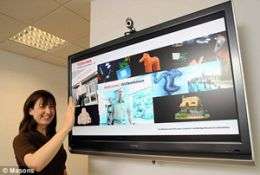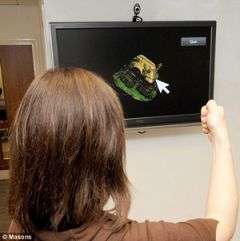A hand signal pauses the new TV
(PhysOrg.com) -- Consumers will soon be able to control their TV screens or home entertainment systems simply by waving their hand, thanks to technology developed by Toshiba's Cambridge Research Laboratory in collaboration with the Department of Engineering at the University of Cambridge.
The new gesture-based interface for flat panel displays was recently shown at a major consumer electronics show in Berlin (IFA).
How to use the TV's computer mouse
Using the Toshiba experimental TV viewers are able to interact with the display system simply by gesturing with their hand. Once the viewer is in front of the display screen, the system will ‘see’ them and invite them to take control of the display simply by raising their hand. As the system can robustly track their hand even under different lighting conditions, the visitor can enjoy controlling the on-screen cursor.
“The gesture-control research is extremely exciting and is opening an array of possibilities for consumers, such as new interfaces for TVs and interactive displays in shop windows and information kiosks,” explains Professor Roberto Cipolla , who with Dr Bjorn Stenger at Toshiba and Tom Woodley at the Department of Engineering, has been pioneering the use of computer vision in human-machine interaction since 1992. All three of whom are Department of Engineering alumni.
“The gesture interface may not replace a remote controller, but can provide an alternative way to interact with a PC or display. Imagine never having to search for the remote controller to turn the TV volume down when receiving a phone call.
“Having developed the system, we are now working on expanding its capabilities to ensure an easy-to-use and reliable system for the consumer which will work in real word scenarios, such as shops or peoples’ living rooms.”
Another vision-based interface has also been developed, viewers will be able to switch the display’s language or contents simply by showing different picture cards. Identification interfaces like this offer the user the ability to personalise either the interface or the contents.
The system uses a single camera mounted on the top of the display and is started by the user raising their hand to initiate the interaction. The software then tracks the person’s hand using multiple cues including colour, motion and appearance. It can reliably recognise and track the user’s gestures even under rapid motion or changing light conditions. Since different cues are less reliable in different situations this multiple-cue approach is key to making a human computer interface work robustly.
The team’s current research focuses on how to deal with multiple users (in a living room setting for example), how to track with finer control and how to deal with difficult lighting systems.
For more information please visit Professor Roberto Cipolla's webpages here.
Provided by University of Cambridge

























